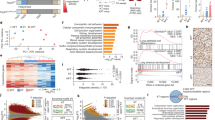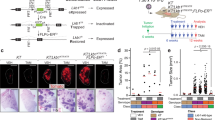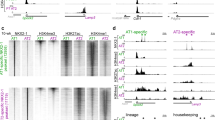Abstract
Mps One Binder Kinase Activator (MOB)1A/1B are core components of the Hippo pathway. These proteins, which coactivate LArge Tumour Suppressor homologue kinases, are also tumour suppressors. To investigate MOB1A/B’s roles in normal physiology and lung cancer, we generated doxycycline (Dox)-inducible, bronchioalveolar epithelium-specific, null mutations of MOB1A/B in mice (SPC-rtTA/(tetO)7-Cre/Mob1aflox/flox/Mob1b−/−; termed luMob1DKO mice). Most mutants (70%) receiving Dox in utero (luMob1DKO (E6.5-18.5) mice) died of hypoxia within 1 h post-birth. Their alveolar epithelial cells showed increased proliferation, impaired YAP1/TAZ-dependent differentiation and decreased surfactant protein production, all features characteristic of human respiratory distress syndrome. Intriguingly, mutant mice that received Dox postnatally (luMob1DKO (P21–41) mice) did not develop spontaneous lung adenocarcinomas, and urethane treatment-induced lung tumour formation was decreased (rather than increased). Lungs of luMob1DKO (P21–41) mice exhibited increased detachment of bronchiolar epithelial cells and decreased numbers of the bronchioalveolar stem cells thought to initiate lung adenocarcinomas. YAP1/TAZ-NKX2.1-dependent expression of collagen XVII, a key hemidesmosome component, was also reduced. Thus, a MOB1-YAP1/TAZ-NKX2.1 axis is essential for normal lung homeostasis and expression of the collagen XVII protein necessary for alveolar stem cell maintenance in the lung niche.
This is a preview of subscription content, access via your institution
Access options
Subscribe to this journal
Receive 50 print issues and online access
$259.00 per year
only $5.18 per issue
Buy this article
- Purchase on Springer Link
- Instant access to full article PDF
Prices may be subject to local taxes which are calculated during checkout






Similar content being viewed by others
References
Nishio M, Otsubo K, Maehama T, Mimori K, Suzuki A . Capturing the mammalian Hippo: elucidating its role in cancer. Cancer Sci 2013; 104: 1271–1277.
Zhao B, Ye X, Yu J, Li L, Li W, Li S et al. TEAD mediates YAP-dependent gene induction and growth control. Genes Dev 2008; 22: 1962–1971.
Kanai F, Marignani PA, Sarbassova D, Yagi R, Hall RA, Donowitz M et al. TAZ: a novel transcriptional co-activator regulated by interactions with 14-3-3 and PDZ domain proteins. EMBO J 2000; 19: 6778–6791.
Zhao B, Li L, Tumaneng K, Wang CY, Guan KL . A coordinated phosphorylation by Lats and CK1 regulates YAP stability through SCF (beta-TRCP). Genes Dev 2010; 24: 72–85.
Wang Y, Dong Q, Zhang Q, Li Z, Wang E, Qiu X . Overexpression of Yes-associated protein contributes to progression and poor prognosis of non-small-cell lung cancer. Cancer Sci 2010; 101: 1279–1285.
Xie M, Zhang L, He CS, Hou JH, Lin SX, Hu ZH et al. Prognostic significance of TAZ expression in resected non-small cell lung cancer. J Thorac Oncol 2012; 7: 799–807.
Chen HY, Yu SL, Ho BC, Su KY, Hsu YC, Chang CS et al. R331W missense mutation of oncogene YAP1 is a germline risk allele for lung adenocarcinoma with medical actionability. J Clin Oncol 2015; 33: 2303–2310.
Sasaki H, Kawano O, Endo K, Suzuki E, Yukiue H, Kobayashi Y et al. Human MOB1 expression in non-small-cell lung cancer. Clin Lung Cancer 2007; 8: 273–276.
Zhou Z, Hao Y, Liu N, Raptis L, Tsao MS, Yang X . TAZ is a novel oncogene in non-small cell lung cancer. Oncogene 2011; 30: 2181–2186.
Giangreco A, Groot KR, Janes SM . Lung cancer and lung stem cells: strange bedfellows? Am J Respir Crit Care Med 2007; 175: 547–553.
Kim CF, Jackson EL, Woolfenden AE, Lawrence S, Babar I, Vogel S et al. Identification of bronchioalveolar stem cells in normal lung and lung cancer. Cell 2005; 121: 823–835.
Whitsett JA, Wert SE, Trapnell BC . Genetic disorders influencing lung formation and function at birth. Hum Mol Genet 2004; 13 (Spec No 2): R207–R215.
Whitsett JA, Wert SE, Weaver TE . Alveolar surfactant homeostasis and the pathogenesis of pulmonary disease. Annu Rev Med 2010; 61: 105–119.
Nishizawa Y, Uematsu J, Owaribe K . HD4, a 180 kDa bullous pemphigoid antigen, is a major transmembrane glycoprotein of the hemidesmosome. J Biochem 1993; 113: 493–501.
Powell AM, Sakuma-Oyama Y, Oyama N, Black MM . Collagen XVII/BP180: a collagenous transmembrane protein and component of the dermoepidermal anchoring complex. Clin Exp Dermatol 2005; 30: 682–687.
Sauer B . Inducible gene targeting in mice using the Cre/lox system. Methods 1998; 14: 381–392.
Perl AK, Wert SE, Nagy A, Lobe CG, Whitsett JA . Early restriction of peripheral and proximal cell lineages during formation of the lung. Proc Natl Acad Sci USA 2002; 99: 10482–10487.
Nishio M, Hamada K, Kawahara K, Sasaki M, Noguchi F, Chiba S et al. Cancer susceptibility and embryonic lethality in Mob1a/1b double-mutant mice. J Clin Invest 2012; 122: 4505–4518.
Srinivas S, Watanabe T, Lin CS, William CM, Tanabe Y, Jessell TM et al. Cre reporter strains produced by targeted insertion of EYFP and ECFP into the ROSA26 locus. BMC. Dev Biol 2001; 1: 4.
Warburton D, Schwarz M, Tefft D, Flores-Delgado G, Anderson KD, Cardoso WV . The molecular basis of lung morphogenesis. Mech Dev 2000; 92: 55–81.
Yamada M, Kurihara H, Kinoshita K, Sakai T . Temporal expression of alpha-smooth muscle actin and drebrin in septal interstitial cells during alveolar maturation. J Histochem Cytochem 2005; 53: 735–744.
Wikenheiser KA, Clark JC, Linnoila RI, Stahlman MT, Whitsett JA . Simian virus 40 large T antigen directed by transcriptional elements of the human surfactant protein C gene produces pulmonary adenocarcinomas in transgenic mice. Cancer Res 1992; 52: 5342–5352.
Chung C, Kim T, Kim M, Kim M, Song H, Kim TS et al. Hippo-Foxa2 signaling pathway plays a role in peripheral lung maturation and surfactant homeostasis. Proc Natl Acad Sci USA 2013; 110: 7732–7737.
Nishio M, Sugimachi K, Goto H, Wang J, Morikawa T, Miyachi Y et al. Dysregulated YAP1/TAZ and TGF-beta signaling mediate hepatocarcinogenesis in Mob1a/1b-deficient mice. Proc Natl Acad Sci USA 2016; 113: E71–E80.
Malkinson AM, Beer DS . Major effect on susceptibility to urethan-induced pulmonary adenoma by a single gene in BALB/cBy mice. J Natl Cancer Inst 1983; 70: 931–936.
Demello DE, Mahmoud S, Ryerse J, Hoffmann JW . Generation and characterization of a conditionally immortalized lung clara cell line from the H-2Kb-tsA58 transgenic mouse. In Vitro Cell Dev Biol Anim 2002; 38: 154–164.
Zhao B, Wei X, Li W, Udan RS, Yang Q, Kim J et al. Inactivation of YAP oncoprotein by the Hippo pathway is involved in cell contact inhibition and tissue growth control. Genes Dev 2007; 21: 2747–2761.
Yanagi S, Kishimoto H, Kawahara K, Sasaki T, Sasaki M, Nishio M et al. Pten controls lung morphogenesis, bronchioalveolar stem cells, and onset of lung adenocarcinomas in mice. J Clin Invest 2007; 117: 2929–2940.
Nishie W, Sawamura D, Goto M, Ito K, Shibaki A, McMillan JR et al. Humanization of autoantigen. Nat Med 2007; 13: 378–383.
Park KS, Whitsett JA, Di Palma T, Hong JH, Yaffe MB, Zannini M . TAZ interacts with TTF-1 and regulates expression of surfactant protein-C. J Biol Chem 2004; 279: 17384–17390.
Wan H, Dingle S, Xu Y, Besnard V, Kaestner KH, Ang SL et al. Compensatory roles of Foxa1 and Foxa2 during lung morphogenesis. J Biol Chem 2005; 280: 13809–13816.
Lin C, Yao E, Chuang PT . A conserved MST1/2-YAP axis mediates Hippo signaling during lung growth. Dev Biol 2015; 403: 101–113.
Lange AW, Sridharan A, Xu Y, Stripp BR, Perl AK, Whitsett JA . Hippo/Yap signaling controls epithelial progenitor cell proliferation and differentiation in the embryonic and adult lung. J. Mol Cell Biol 2015; 7: 35–47.
Horio Y, Chen A, Rice P, Roth JA, Malkinson AM, Schrump DS . Ki-ras and p53 mutations are early and late events, respectively, in urethane-induced pulmonary carcinogenesis in A/J mice. Mol Carcinog 1996; 17: 217–223.
Westcott PM, Halliwill KD, To MD, Rashid M, Rust AG, Keane TM et al. The mutational landscapes of genetic and chemical models of Kras-driven lung cancer. Nature 2015; 517: 489–492.
Ventura JJ, Tenbaum S, Perdiguero E, Huth M, Guerra C, Barbacid M et al. p38alpha MAP kinase is essential in lung stem and progenitor cell proliferation and differentiation. Nat Genet 2007; 39: 750–758.
Dovey JS, Zacharek SJ, Kim CF, Lees JA . Bmi1 is critical for lung tumorigenesis and bronchioalveolar stem cell expansion. Proc Natl Acad Sci USA 2008; 105: 11857–11862.
McGrath JA, Gatalica B, Christiano AM, Li K, Owaribe K, McMillan JR et al. Mutations in the 180-kD bullous pemphigoid antigen (BPAG2), a hemidesmosomal transmembrane collagen (COL17A1), in generalized atrophic benign epidermolysis bullosa. Nat Genet 1995; 11: 83–86.
Matsumura H, Mohri Y, Binh NT, Morinaga H, Fukuda M, Ito M et al. Hair follicle aging is driven by transepidermal elimination of stem cells via COL17A1 proteolysis. Science 2016; 351: aad4395.
Tanimura S, Tadokoro Y, Inomata K, Binh NT, Nishie W, Yamazaki S et al. Hair follicle stem cells provide a functional niche for melanocyte stem cells. Cell Stem Cell 2011; 8: 177–187.
Mitani A, Nagase T, Fukuchi K, Aburatani H, Makita R, Kurihara H . Transcriptional coactivator with PDZ-binding motif is essential for normal alveolarization in mice. Am J Respir Crit Care Med 2009; 180: 326–338.
Kim M, Kim T, Johnson RL, Lim DS . Transcriptional co-repressor function of the hippo pathway transducers YAP and TAZ. Cell Rep 2015; 11: 270–282.
Valencia-Sama I, Zhao Y, Lai D, Janse van Rensburg HJ, Hao Y, Yang X . Hippo component TAZ functions as a co-repressor and negatively regulates DeltaNp63 transcription through TEA domain (TEAD) transcription factor. J Biol Chem 2015; 290: 16906–16917.
Makita R, Uchijima Y, Nishiyama K, Amano T, Chen Q, Takeuchi T et al. Multiple renal cysts, urinary concentration defects, and pulmonary emphysematous changes in mice lacking TAZ. Am J Physiol Renal Physiol 2008; 294: F542–F553.
Corti M, Brody AR, Harrison JH . Isolation and primary culture of murine alveolar type II cells. Am J Respir Cell Mol Biol 1996; 14: 309–315.
Debbabi H, Ghosh S, Kamath AB, Alt J, Demello DE, Dunsmore S et al. Primary type II alveolar epithelial cells present microbial antigens to antigen-specific CD4+ T cells. Am J Physiol Lung Cell Mol Physiol 2005; 289: L274–L279.
Driscoll B, Kikuchi A, Lau AN, Lee J, Reddy R, Jesudason E et al. Isolation and characterization of distal lung progenitor cells. Methods Mol Biol 2012; 879: 109–122.
Nakayama H, Morozumi T, Nanto S, Shimonagata T, Ohara T, Takano Y et al. Abnormal myocardial free fatty acid utilization deteriorates with morphological changes in the hypertensive heart. Jpn Circ J 2001; 65: 783–787.
Coleman CM, Wu L . HIV interactions with monocytes and dendritic cells: viral latency and reservoirs. Retrovirology 2009; 6: 51.
Acknowledgements
We are grateful to Dr Jeffrey A Whitsett (Division of Pulmonary Biology, Cincinnati Children’s Hospital Medical Center, USA) for giving us SPC-rtTA/(tetO)7-Cre mice, and to A Fujimoto, M Kamihashi and M Suzuki (all of Kyushu Univ.), S Maegawa, J Utsumi, F Ishikawa, M Seiki and T Noda (all of AMED), for expert technical assistance and helpful discussions. This work was supported by MEXT and JSPS (grants 26860214 to MN, 24240120 to AS and HG); the Cooperative Research Project Program of the Medical Institute of Bioregulation, Kyushu University; P-DIRECT (grants 11088019 to AS); AMED (grants 16770279 to AS and HG); and the Uehara Memorial Foundation (to AS).
Author information
Authors and Affiliations
Corresponding author
Ethics declarations
Competing interests
The authors declare no conflict of interest.
Additional information
Supplementary Information accompanies this paper on the Oncogene website
Rights and permissions
About this article
Cite this article
Otsubo, K., Goto, H., Nishio, M. et al. MOB1-YAP1/TAZ-NKX2.1 axis controls bronchioalveolar cell differentiation, adhesion and tumour formation. Oncogene 36, 4201–4211 (2017). https://doi.org/10.1038/onc.2017.58
Received:
Revised:
Accepted:
Published:
Issue Date:
DOI: https://doi.org/10.1038/onc.2017.58
This article is cited by
-
Alveolar epithelial cells are competent producers of interstitial extracellular matrix with disease relevant plasticity in a human in vitro 3D model
Scientific Reports (2023)
-
Circular RNA circCCDC85A inhibits breast cancer progression via acting as a miR-550a-5p sponge to enhance MOB1A expression
Breast Cancer Research (2022)
-
Reduced expression of Collagen 17A1 in naturally aged, photoaged, and UV-irradiated human skin in vivo: Potential links to epidermal aging
Journal of Cell Communication and Signaling (2022)
-
Loss of Mob1a/b impairs the differentiation of mouse embryonic stem cells into the three germ layer lineages
Experimental & Molecular Medicine (2019)
-
PTEN–GSK3β–MOB1 axis controls neurite outgrowth in vitro and in vivo
Cellular and Molecular Life Sciences (2018)



